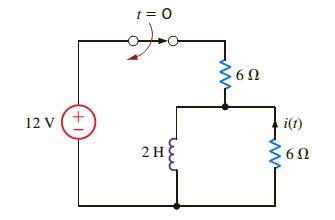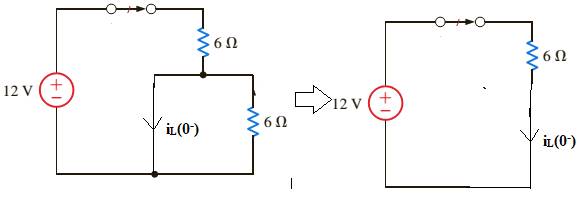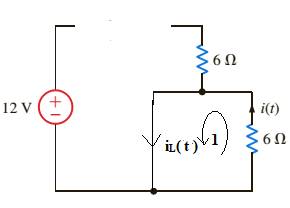
Concept explainers
Use the differential equation approach to find i(t) for

The current
Answer to Problem 1P
Explanation of Solution
Given information:
Given circuit is shown below

Fig: Given circuit diagram
Calculation:
Although for -

Fig: Circuit diagram for
Now, draw the circuit when switch is opened at t =0.

Fig: circuit diagram for
Apply KVL for loop 1
Standard from of solution of above equation is
Plugging
Therefore,
Now, from equation (1),
Want to see more full solutions like this?
Chapter 7 Solutions
Basic Engineering Circuit Analysis
Additional Engineering Textbook Solutions
Web Development and Design Foundations with HTML5 (8th Edition)
Starting Out with C++ from Control Structures to Objects (9th Edition)
Concepts Of Programming Languages
Computer Science: An Overview (13th Edition) (What's New in Computer Science)
Database Concepts (8th Edition)
Degarmo's Materials And Processes In Manufacturing
- Please show all the steps!arrow_forward10-3) similar to Lathi & Ding, Prob. P.6.3-7 The Fourier transform P(f) of a the basic pulse p(t) used in a certain binary communication is shown in the figure below: P(f) 1 0.5 0 f₁ = 0.8 √₂ = 1.2 f, MHz (a) From the shape of P(f), explain at what pulse rate this pulse would satisfy Nyquist's first criterion. (b) Assuming that the pulse is a raised-cosine pulse, find its rolloff factor. (c) Find p(t) and verify that this pulse satisfies Nyquist's first criterion in the time domain. (d) Show how rapidly the pulse decays as a function of t, (i.e., what power of t does the envelope obey for large time values).arrow_forwardDon't use ai to answer I will report you answerarrow_forward
- Don't use ai to answer I will report you answerarrow_forwardDon't use ai to answer I will report you answerarrow_forwardChoose the correct answer for from the following sentences: 1. The purpose of the microprocessor is to control b. memory c. processing d. tasks a. switches 2. Which of the following instructions represents base-plus-index addressing mode? a. MOV AL,[BX] b. MOV AL,[SI] c. MOV AL,BX d. MOV AL,[BX+SI] 3. The BIU pre-fetches the instruction from memory and store them in b. memory c. stack d. queue a. register 4. Which function is used to control the PWM (Pulse Width Modulation) on the Arduino output pin? a. digitalRead() b. analogRead() c. digitalWrite() 5. Which port in the PIC16F877A has an 8 external interrupt inputs? a. Port-A b. Port-C c. Port-B d. analogWrite() d. Port-D d. 4KByte 6. How much Flash EEPROM memory program found in the PIC16F877A microcontroller? a. 32KByte b. 16KByte c. 8KBytearrow_forward
- Solve and select the correct answer: 2. For a random variable X with pdf: p(x) value of x is = 119 10 for -5≤x≤5. The mean (a) -75 (b) 10 (c) 0 (d) 75 3. Is the matrix A = = [1] orthogonal? Find the rank of A? 0 (a) YES, -1 (b) NO, 2 (c) YES, 2 (d) NO, -1 4. L{et sin(3t)u(t)) = (a) s-3 (s-2)²+9 2 (b) (5-3)² (c) (s-3)²+4 S-2 3 (s-2)²+9 (d) (5-2)²+9 = 5. Given that x is a constant. Choose all the correct solutions for [∞ (AB)] = (a) (AB)T (b) x ATBT (c) α BTAT (d) x (AB)Tarrow_forwardDO NOT WANT AI WILL REJECTarrow_forward3. Roughly sketch the root locus for the following locations of open-loop poles and zeros. You just need to show the shape of the root locus; you do not calculate the asymptote, break-in, and break-away points. ☑ (a) (b) ☑ Φ ① $3 (c)arrow_forward
 Power System Analysis and Design (MindTap Course ...Electrical EngineeringISBN:9781305632134Author:J. Duncan Glover, Thomas Overbye, Mulukutla S. SarmaPublisher:Cengage Learning
Power System Analysis and Design (MindTap Course ...Electrical EngineeringISBN:9781305632134Author:J. Duncan Glover, Thomas Overbye, Mulukutla S. SarmaPublisher:Cengage Learning
